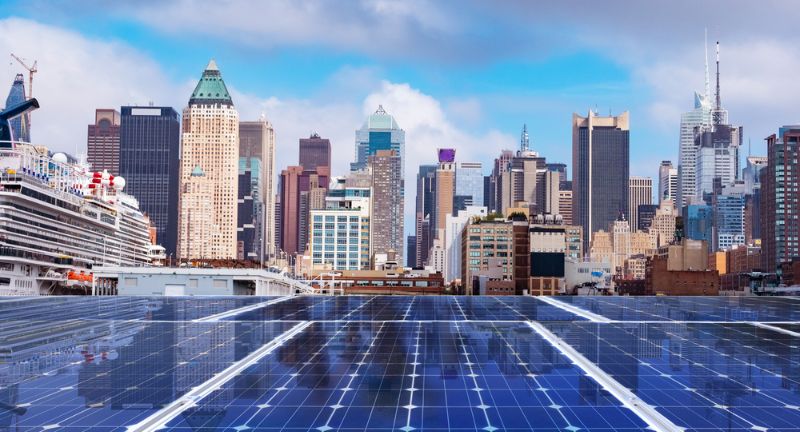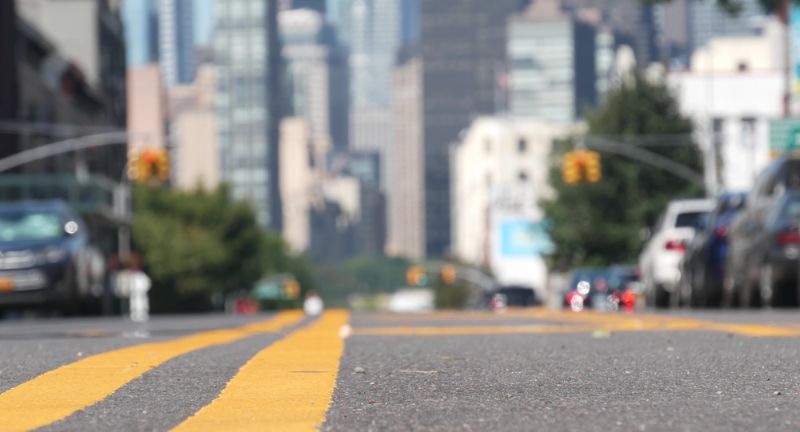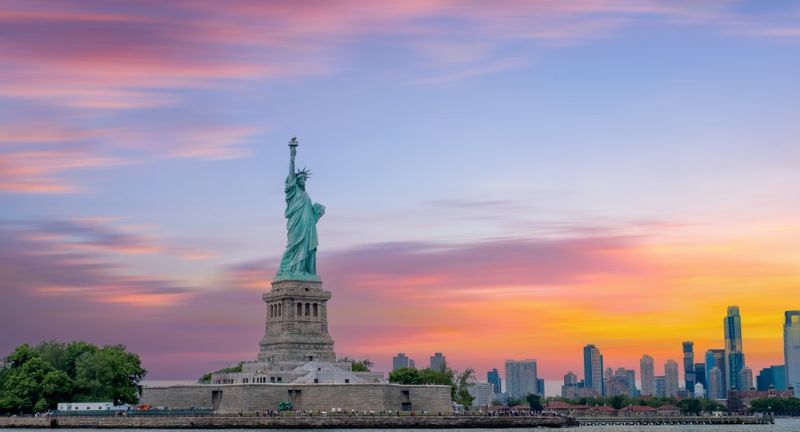EXPLORE
24 Facts About The Big Apple You Probably Didn’t Know
Published
4 months agoon

New York City, known as the Big Apple, is filled with fascinating history, hidden secrets, and unexpected quirks that even locals may not know about. From its famous landmarks to lesser-known cultural treasures, the city has layers of stories waiting to be discovered. Each neighborhood holds a unique piece of NYC’s past and present, contributing to its global appeal. Beyond the iconic skyline and bustling streets, surprising facts reveal the city’s diverse influences and rich heritage. Here’s a collection of 25 interesting facts about NYC that highlight what makes this vibrant city truly one-of-a-kind.
The Origin of “Big Apple”

Shutterstock
The nickname “Big Apple” became widely popular in the 1920s, thanks to sports writer John J. Fitz Gerald. He picked it up from New Orleans stable hands who used it to refer to NYC racetracks as places of high stakes and big wins. Decades later, a tourism campaign in the 1970s brought the term back into the limelight as a positive representation of the city. Today, “Big Apple” is an iconic nickname that symbolizes New York City’s energy, resilience, and boundless opportunities.
The City That Almost Wasn’t the Capital

Shutterstock
New York City briefly served as the capital of the United States in 1789, an honor it held for just one year. The government soon moved the capital to Philadelphia and later to Washington, D.C., where it remains today. If history had gone differently, New York could have retained its place as the political center of the country. Instead, it focused on becoming a global hub of commerce, culture, and innovation.
The Statue of Liberty’s Torch Replacement

Shutterstock
In 1984, the original torch of the Statue of Liberty was replaced due to severe water damage, and a new torch, coated in 24-karat gold leaf, was installed. The original torch now rests in the Statue of Liberty Museum for visitors to see up close. The statue itself was a gift from France in 1886, symbolizing freedom and friendship between the nations. Today, Lady Liberty stands proudly in New York Harbor, shining brightly as a beacon of hope and opportunity.
A Linguistic Melting Pot

Shutterstock
New York City is home to over 800 languages, making it one of the most linguistically diverse places on Earth. Neighborhoods like Queens are renowned for their cultural diversity, where dozens of languages can be heard in a single walk down the street. This rich tapestry of languages reflects the city’s role as a gateway to immigrants from around the world. NYC’s linguistic diversity is a living testament to its status as a true melting pot and cultural hub.
Central Park’s Hidden Waterfalls

Shutterstock
Central Park, spanning 843 acres, is home to several hidden waterfalls, most of which are found in the park’s northern areas. Designed by landscape architects Frederick Law Olmsted and Calvert Vaux, these artificial waterfalls add an element of tranquility to the park. Fed by the city’s water system, these hidden gems create a natural escape within the heart of the city. Central Park’s waterfalls offer a peaceful retreat for locals and visitors alike amid NYC’s hustle and bustle.
More Than Just Skyscrapers

Shutterstock
Despite being famous for its towering skyscrapers, about 90% of New York City’s buildings are actually under six stories tall. Much of the city’s architectural history predates the high-rise boom, with zoning laws further limiting building height in many neighborhoods. This blend of low-rise and high-rise structures adds character to the city’s landscape. Iconic skyscrapers may define NYC’s skyline, but the smaller buildings give it depth and charm.
Cherry Blossom Festival at the Brooklyn Botanic Garden

Shutterstock
Every spring, the Brooklyn Botanic Garden hosts the “Sakura Matsuri” cherry blossom festival, celebrating Japanese culture and showcasing the stunning cherry blossoms in bloom. Thousands of visitors flock to see the trees adorned with delicate pink flowers, turning the garden into a picturesque scene. The event includes cultural performances, food, and activities inspired by Japanese traditions. The festival is one of the city’s most beloved springtime celebrations and a beautiful reminder of NYC’s multicultural spirit.
The Birthplace of Pizza in the United States

Shutterstock
Lombardi’s Pizza, located in Little Italy, holds the honor of being the first pizzeria in the United States, opening its doors in 1905. Known for its iconic New York-style pizza with a thin crust, Lombardi’s has set the standard for pizza in the city. The distinct taste of NYC pizza is often attributed to the city’s water, which some believe adds to its flavor. Today, pizza is a beloved NYC staple, and Lombardi’s remains a must-visit for food lovers worldwide.
Greenwich Village’s Unique Street Layout

Shutterstock
Unlike the grid system that defines most of Manhattan, Greenwich Village has an irregular, twisting street layout that dates back to before the 1811 grid plan. This historic neighborhood’s streets have a unique charm, often leaving visitors pleasantly lost amid its maze-like design. The lack of a strict grid creates a cozy, old-world feel, complemented by charming architecture and narrow lanes. Greenwich Village’s winding roads contribute to its reputation as a bohemian and artistic enclave within the city.
The Hidden Subway Station at City Hall

Shutterstock
The original City Hall subway station, which opened in 1904, is now closed to the public but remains a hidden gem beneath NYC. Featuring intricate tile work, chandeliers, and skylights, the station resembles an underground art gallery. While it is no longer in use, visitors can catch a glimpse of this historical marvel by riding the 6 train’s turnaround loop or joining guided tours. City Hall station offers a peek into New York’s early subway history and architectural elegance.
Solar Power in Times Square

Shutterstock
Many of Times Square’s famous signs and billboards are now powered by renewable energy, including solar power. This eco-friendly initiative offsets the energy consumption in this neon-lit area, known for its vibrant LED displays. Even the iconic New Year’s Eve ball drop has adopted more sustainable practices in recent years. NYC’s efforts to go green in one of its most brightly lit areas is a step toward a more sustainable future for the city.
Grand Central’s Whispering Gallery

Shutterstock
In Grand Central Terminal, the “whispering gallery” is a fun architectural quirk where sound travels exceptionally well. Standing at opposite corners of the arched hallway, people can whisper and be heard clearly on the other side. This phenomenon delights curious visitors, adding a bit of magic to the terminal’s grandiose design. The whispering gallery is one of Grand Central’s hidden surprises, revealing the building’s architectural intricacies.
The Bronx Zoo: The World’s Largest Urban Zoo

Shutterstock
Spanning 265 acres, the Bronx Zoo is the largest urban zoo in the world, housing over 6,000 animals from various species. Opened in 1899, it was one of the first zoos to provide animals with naturalistic habitats rather than cages. The zoo has since become a leader in wildlife conservation and education. Visitors from around the globe flock to explore this expansive urban wildlife sanctuary.
The Empire State Building’s WWII Role

Shutterstock
During World War II, the Empire State Building served as an aircraft lookout post, with volunteers monitoring the skies for potential enemy planes. Positioned high above the city, it offered an ideal vantage point and contributed to the city’s wartime defenses. This iconic skyscraper, famous for its Art Deco design, played an unexpected role in the nation’s history. Today, it remains a symbol of NYC’s resilience and strength.
NYC’s First Underground Park

Shutterstock
The Lowline, a planned underground park in NYC, aims to transform an old trolley terminal into a lush, subterranean green space. Using mirrors and fiber-optic technology, sunlight will be channeled underground to sustain plant life. Although still under development, the Lowline represents an innovative approach to urban green space in densely populated areas. It reflects NYC’s commitment to sustainability and forward-thinking design.
Pompeii Fresco at the MET

Shutterstock
The Metropolitan Museum of Art houses an ancient fresco from Pompeii, Italy, a rare artifact that survived the volcanic eruption in 79 A.D. This incredible piece of history allows visitors to connect with ancient Rome, showcasing art that has endured for centuries. The fresco is part of the MET’s vast collection spanning over 5,000 years of history. The museum offers an unparalleled journey through time and culture.
Stargazing at the High Line

Shutterstock
Every summer, the High Line hosts free stargazing nights where the Amateur Astronomers Association brings telescopes for public use. Visitors can look through telescopes and experience the stars in the city, a unique blend of nature and urban life. This elevated park, created from a former rail track, has become a favorite spot for New Yorkers and tourists alike. The High Line offers a peaceful retreat to connect with the night sky amid NYC’s skyline.
NYC’s First Paved Road

Shutterstock
In 1658, Bowling Green Park became New York City’s first paved road, and it remains a historic landmark in Lower Manhattan. Today, the area houses Wall Street and the Charging Bull sculpture, marking it as a financial hub. Bowling Green is one of NYC’s oldest public parks, showcasing the city’s evolution from colonial times. The cobblestone streets and historical sites give a glimpse into the city’s early days.
Scenic Views from the Roosevelt Island Tramway

Shutterstock
The Roosevelt Island Tramway offers breathtaking views of the East River and Midtown Manhattan as it travels from Roosevelt Island to the city. Opened in 1976, it was North America’s first commuter tram and remains a unique way to travel and see the sights. Often compared to a theme park ride, the tram is both practical and scenic. It’s a favorite for tourists and locals alike, providing stunning cityscapes and a different perspective of NYC.
Astoria’s “Little Australia”

Shutterstock
Astoria, Queens, has a growing “Little Australia,” featuring authentic Australian cafes, restaurants, and specialty shops. Here, you can find classic Aussie staples like flat whites, meat pies, and even Vegemite on toast. This pocket of Australian culture has become a vibrant and beloved part of Astoria’s diverse community. Little Australia brings a taste of Down Under to NYC, attracting both locals and tourists seeking a unique experience.
The Brooklyn Bridge Walkway

Shutterstock
The Brooklyn Bridge’s pedestrian walkway is 1.1 miles long and offers stunning views of the Manhattan skyline. Completed in 1883, the bridge was the first steel-wire suspension bridge in the world and remains a marvel of engineering. Millions of walkers and cyclists cross the bridge each year, drawn by its historic significance and breathtaking views. The Brooklyn Bridge is an enduring symbol of NYC’s architectural prowess and spirit.
NYC’s Iconic Water Towers

Shutterstock
New York City’s water towers, found on rooftops throughout the city, are essential for maintaining water pressure in high-rise buildings. Many of these iconic structures date back over a century, blending function with industrial charm in the NYC skyline. The water towers remain a unique feature of the city, giving NYC’s rooftops an unmistakable look. They’re an example of the city’s ability to blend the old with the new, adapting to growth while preserving character.
Nom Wah Tea Parlor: NYC’s Oldest Dim Sum Restaurant

Shutterstock
Nom Wah Tea Parlor, located in Chinatown, has been serving authentic dim sum since 1920. This long-standing restaurant is a culinary landmark, offering classic dishes in a nostalgic setting. The tea parlor represents NYC’s historic Chinese community and continues to draw in both locals and tourists. With its delicious dim sum and rich history, Nom Wah has become an essential stop for anyone exploring Chinatown.
The Secret Subway Track Beneath the Waldorf Astoria

Shutterstock
Beneath the Waldorf Astoria Hotel lies a secret subway platform, Track 61, used by President Franklin D. Roosevelt for discreet arrivals and departures. This hidden track allowed him to avoid public crowds and enter the hotel privately. Although no longer in use, Track 61 remains a part of NYC’s intriguing history and hidden mysteries. It’s a reminder of the city’s layered history, with stories hidden beneath its bustling streets.
Conclusion

Shutterstock
New York City’s unique history, cultural diversity, and unexpected secrets make it one of the world’s most captivating places. Each fact reveals a different layer of the Big Apple, showing how this iconic city constantly evolves while preserving its rich heritage. From its hidden subway stations to its world-famous skyline, NYC is filled with surprises around every corner. These little-known facts remind us that there’s always more to discover, even in the most familiar places. Exploring NYC’s many stories deepens our appreciation for this extraordinary city.
More From Local News X
-


A Boomer’s Guide To Retirement, 25 Tips To Be Prepared…
-


22 Movies Throughout History That Have Shaped The Children’s Toy…
-


28 Ingredients To Look Out For On Your Food Labels…
-


22 Top Things To Consider Before You Pack Up And…
-


25 Strangest World Records That Don’t Seem Real
-


25 Shocking Discoveries Made In The Last 25 Years
-


25 Most Influential Inventions That Baby Boomers Have Witnessed Come…
-


25 States That Have The Happiest People
-


26 Things That People Under 30 May Not Understand
-


30 Things To Do Before Turning 30 Years Old
-


25 Things Older Married Couples Say Are The Key To…
-


20 Most Beautiful Actresses Of All Time According To Popular…
